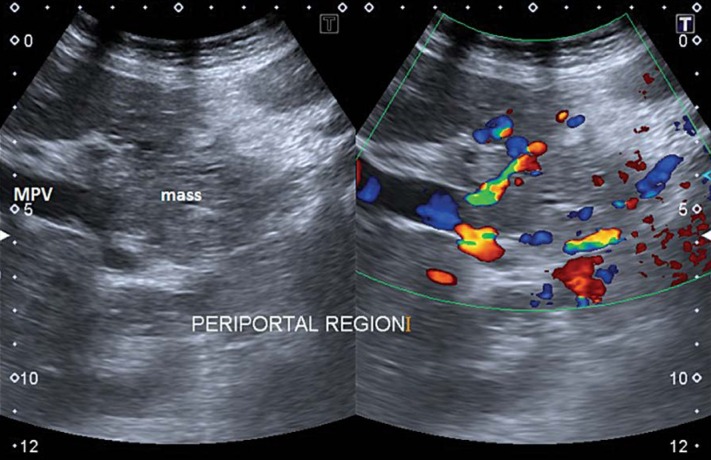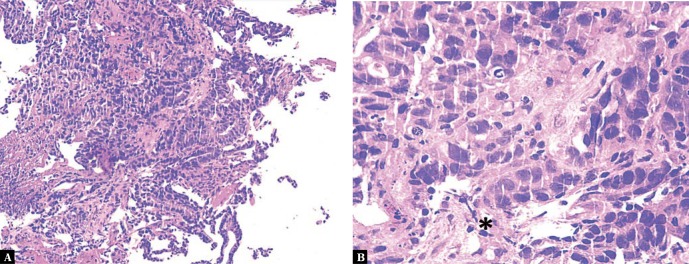Abstract
A 53-year-old woman presented with left-sided abdominal pain, nausea and vomiting for the past 3 months with associated loss of appetite and weight. On physical examination, there was a large, ill-defined, firm mass at the epigastrium. Ultrasonography showed heterogeneously hypoechoic filling defect within the dilated main portal vein. The filling defect showed florid signals on Doppler mode and it appeared to be an extension of a larger periportal mass. Contrast enhanced abdominal computed tomography confirmed a large distal gastric mass infiltrating into the periportal structures, including the main portal vein and the splenic vein. Esophagogastroduodenoscopy performed 2 days later showed an irregular, exophytic mass extending from the antrum into the first part of duodenum. The mass was deemed inoperable. Histopathological examination showed gastric adenocarcinoma. She was started on anticoagulant, chemotherapy and pain management. Follow-up computed tomography 4 months later showed liver metastases and formation of collateral blood vessels.
Keywords: stomach neoplasms, portal vein, thrombosis, ultrasonography
A 53-year-old woman presented with left-sided abdominal pain, nausea and vomiting persisting for the past 3 months with significant loss of appetite and weight. On physical examination, she was cachexic but alert. Vital signs were normal. There was a large, ill-defined, firm mass at the epigastrium with mild tenderness. No hepatosplenomegaly.
Full blood count revealed microcytic hypochromic anemia. Hemoglobin was low (8.5 umol/L) on admission. Serum iron analysis was normal. Tumor markers, which included CA 125, CA19-9, serum alpha-fetoprotein and serum carcinoembryonic antigen, were normal.
Ultrasonography showed heterogeneously hypoechoic filling defect within the dilated main portal vein. The filling defect showed florid signals on Doppler mode and it appeared to be an extension from a larger periportal mass (Fig. 1). Contrast enhanced abdominal computed tomography (CT) confirmed a large distal gastric mass infiltrating into the periportal structures, including the main portal vein and the splenic vein (Fig. 2). There were also multiple enlarged periportal and perigastric nodes.
Fig. 1.
Transverse sonography at periportal region showed an irregular hypoechoic mass infiltrating into the main portal vein (MPV). Florid signals seen throughout the mass on Doppler mode
Fig. 2.
Contrast-enhanced CT in coronal sections showed irregular, heterogeneously enhancing mass (asterisk) arising from the gastric antrum infiltrating into the duodenum (D) and into the main portal vein (MPV)
Esophagogastroduodenoscopy (EGD) performed 2 days later showed an irregular, exophytic mass extending from the antrum into the first part of duodenum. Histopathological examination of the mass showed tumor tissue admixed with gastric mucosae. The tumor tissue was infiltrated by malignant glands exhibiting moderate pleomorphism (Fig. 3). There was also tumor necrosis.
Fig. 3.
A. Histopathological examination in 10 × magnification showing irregular malignant glands infiltrating fibrous stroma. B. Histopathological examination in 40 × magnification showing malignant glands (asterisk)
The mass was deemed inoperable and palliative care was initiated. Enteral stent was inserted to relieve gastric obstructive symptoms and soft diet was recommended. The patient was started on anticoagulant (subcutaneous enoxaparin), 3 cycles of chemotherapy (IV Epirubicin, IV Cisplatin and IV 5-fluorouracil) and pain management. She complied with the treatment and had fewer symptoms over time. A follow-up CT scan four months later showed new liver metastases and formation of collateral blood supplies to the liver (Fig. 4). She was then referred to a tertiary oncology hospital for subsequent management and follow-up.
Fig. 4.
Contrast-enhanced CT in coronal sections 4 months later showed metallic stent (S) within a larger tumor. Increased portal vein infiltration causing formation of collateral blood supplies (arrowheads) to the liver. Presence of multiple new liver metastases (arrows)
Discussion
Gastric carcinoma is the fourth most common carcinoma and the second leading cause of cancer-related deaths. Two-thirds of cases occur in developing countries with most incidences recorded in Japan and South Korea. Incidence peaks at 50–70 years old with male to female ratio of 2:1(1). Risk factors for gastric carcinoma are multifactorial, involving both inherited and environmental factors such as diet (high intake of red meat, salted and smoked food), smoking and Helicobacter pylori infections(2). Pathologically, 90% of stomach cancers are adenocarcinomas(1).
The lack of early pathognomonic symptoms often delays the diagnosis. Consequently, 80% to 90% of patients with gastric cancer present with locally advanced or metastatic tumors that have poor rates of resectability. Nausea, vomiting and early satiety may occur with bulky tumors that obstruct the gastrointestinal lumen or infiltrative lesions that impair stomach distension, such as in our case. Ulcerated tumors may cause bleeding that manifests as hematemesis, melena, or massive upper gastrointestinal hemorrhage(3). Ultrasonography, CT scan and esophagogastroduodenoscopy are important tools for gastric carcinoma assessment. There is no specific tumor marker for gastric carcinoma.
Ultrasonography is often the first imaging modality used for the assessment of palpable abdominal masses. In addition to identifying portal vein thrombosis, the Doppler mode is also useful in identifying the nature of the thrombus. The presence of florid Doppler signals within the filing defect would confirm that it is comprised of soft tissue rather than blood clot. This is particularly important in district settings where CT scan may not be immediately accessible for further characterization of the thrombus. This finding will facilitate further workup and treatment for invasive periportal malignancy rather than medical causes of portal vein thrombosis.
Accurate identification and diagnosis of portal vein tumor thrombus (PVTT) against non-neoplastic thrombosis are particularly important in advanced hepatocellular carcinoma as the presence of PVTT carries a significantly poorer prognosis. On the other hand, there is scarcity of data on PVTT due to other cancers. According to pathological autopsies from Japan, PVTT originating from gastric cancer is rare and reported to account for merely 1.2%(4).
PVTT from gastric carcinoma also carries a grim prognosis with median survival of 5.4 months. Some significant risk factors associated with short median survival are older age, female gender and hepatic mass type of PVTT. Definitive management is controversial as surgical resection of the primary tumor, with or without thrombectomy of PVTT, does not seem to contribute to improved survival rates(4).
Footnotes
Conflict of interest
Authors do not report any financial or personal connections with other persons or organizations, which might negatively affect the contents of this publication and/or claim authorship rights to this publication.
Consent
Consent obtained from the patient for publication of the case details.
References
- 1.Crew KD, Neugut AI: Epidemiology of gastric cancer. World J Gastroenterol 2006; 12: 354–262. [DOI] [PMC free article] [PubMed] [Google Scholar]
- 2.Giordano A, Cito L: Advances in gastric cancer prevention. World J Clin Oncol 2012; 3: 128–136. [DOI] [PMC free article] [PubMed] [Google Scholar]
- 3.Belli L, Romani F, Riolo F, Rondinara G, Aseni P, Di Stefano M. et al. : Thrombosis of portal vein in absence of hepatic disease. Surg Gynecol Obstet 1989; 169: 46–49. [PubMed] [Google Scholar]
- 4.Eom BW, Lee JH, Lee JS, Kim MJ, Ryu KW, Choi IJ. et al. : Survival analysis of gastric cancer patients with tumor thrombus in the portal vein. J Surg Oncol 2012; 105: 310–315. [DOI] [PubMed] [Google Scholar]






